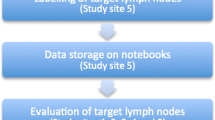Abstract
Therapy monitoring in oncological patient care requires accurate and reliable imaging and post-processing methods. RECIST criteria are the current standard, with inherent disadvantages. The aim of this study was to investigate the feasibility of semi-automated volumetric analysis of lymph node metastases in patients with malignant melanoma compared to manual volumetric analysis and RECIST. Multislice CT was performed in 47 patients, covering the chest, abdomen and pelvis. In total, 227 suspicious, enlarged lymph nodes were evaluated retrospectively by two radiologists regarding diameters (RECIST), manually measured volume by placement of ROIs and semi-automated volumetric analysis. Volume (ml), quality of segmentation (++/−−) and time effort (s) were evaluated in the study. The semi-automated volumetric analysis software tool was rated acceptable to excellent in 81% of all cases (reader 1) and 79% (reader 2). Median time for the entire segmentation process and necessary corrections was shorter with the semi-automated software than by manual segmentation. Bland-Altman plots showed a significantly lower interobserver variability for semi-automated volumetric than for RECIST measurements. The study demonstrated feasibility of volumetric analysis of lymph node metastases. The software allows a fast and robust segmentation in up to 80% of all cases. Ease of use and time needed are acceptable for application in the clinical routine. Variability and interuser bias were reduced to about one third of the values found for RECIST measurements.





Similar content being viewed by others
References
Herbst RS, Bajorin DF, Bleiberg H et al (2006) Clinical cancer advances 2005: major research advances in cancer treatment, prevention, and screening-a report from the American Society of Clinical Oncology. J Clin Oncol 24:190–205
Miller AB, Hoogstraten B, Staquet M, Winkler A (1981) Reporting results of cancer treatment. Cancer 47:207–214
Husband JE, Schwartz LH, Spencer J et al (2004) Evaluation of the response to treatment of solid tumours-a consensus statement of the International Cancer Imaging Society. Br J Cancer 90:2256–2260
Padhani AR, Ollivier L (2001) The RECIST (Response Evaluation Criteria in Solid Tumors) criteria: implications for diagnostic radiologists. Br J Radiol 74:983–986
James K, Eisenhauer E, Christian M et al (1999) Measuring response in solid tumors: unidimensional versus bidimensional measurement. J Natl Cancer Inst 91:523–528
Park JO, Lee SI, Song SY et al (2003) Measuring response in solid tumors: comparison of RECIST and WHO response criteria. Jpn J Clin Oncol 33:533–537
Warr D, McKinney S, Tannock I (1984) Influence of measurement error on assessment of response to anticancer chemotherapy: proposal for new criteria of tumor response. J Clin Oncol 2:1040–1046
Erasmus JJ, Gladish GW, Broemeling L et al (2003) Interobserver and intraobserver variability in measurement of non-small-cell carcinoma lung lesions: implications for assessment of tumor response. J Clin Oncol 21:2574–2582
Thiesse P, Ollivier L, Di Stefano-Louineau D et al (1997) Response rate accuracy in oncology trials: reasons for interobserver variability. Groupe Francais d’Immunotherapie of the Federation Nationale des Centres de Lutte Contre le Cancer. J Clin Oncol 15:3507–3514
Schwartz LH, Mazumdar M, Brown W, Smith A, Panicek DM (2003) Variability in response assessment in solid tumors: effect of number of lesions chosen for measurement. Clin Cancer Res 9:4318–4323
Prasad SR, Jhaveri KS, Saini S, Hahn PF, Halpern EF, Sumner JE (2002) CT tumor measurement for therapeutic response assessment: comparison of unidimensional, bidimensional, and volumetric techniques initial observations. Radiology 225:416–419
Wormanns D, Kohl G, Klotz E et al (2004) Volumetric measurements of pulmonary nodules at multi-row detector CT: in vivo reproducibility. Eur Radiol 14:86–92
Yankelevitz DF, Reeves AP, Kostis WJ, Zhao B, Henschke CI (2000) Small pulmonary nodules: volumetrically determined growth rates based on CT evaluation. Radiology 217:251–256
Bornemann L, Dicken V, Kuhnigk JM et al (2007) OncoTREAT: a software assistant for cancer therapy monitoring. Int J Compu Assist Radiology and Surgery (Int J CARS) 1:231–242
Bornemann L, Kuhnigk JM, Dicken V et al (2005) Informatics in radiology (infoRAD): new tools for computer assistance in thoracic CT part 2. Therapy monitoring of pulmonary metastases. Radiographics 25:841–848
Bland JM, Altman DG (1986) Statistical methods for assessing agreement between two methods of clinical measurement. Lancet 1:307–310
Bolte H, Riedel C, Jahnke T et al (2006) Reproducibility of computer-aided volumetry of artificial small pulmonary nodules in ex vivo porcine lungs. Invest Radiol 41:28–35
Sohaib SA, Turner B, Hanson JA, Farquharson M, Oliver RT, Reznek RH (2000) CT assessment of tumour response to treatment: comparison of linear, cross-sectional and volumetric measures of tumour size. Br J Radiol 73:1178–1184
Marten K, Auer F, Schmidt S, Kohl G, Rummeny EJ, Engelke C (2006) Inadequacy of manual measurements compared to automated CT volumetry in assessment of treatment response of pulmonary metastases using RECIST criteria. Eur Radiol 16:781–790
Acknowledgment
We would like to thank our technicians Martina Jochim and Adelheid Fuxa for performing the CT examinations and data transfer support.
Conflict of interest statement
H.-U. Kauczor holds research grants from Siemens Medical Solutions and Toshiba Medical Systems.
Author information
Authors and Affiliations
Corresponding author
Rights and permissions
About this article
Cite this article
Fabel, M., von Tengg-Kobligk, H., Giesel, F.L. et al. Semi-automated volumetric analysis of lymph node metastases in patients with malignant melanoma stage III/IV-A feasibility study. Eur Radiol 18, 1114–1122 (2008). https://doi.org/10.1007/s00330-008-0866-4
Received:
Revised:
Accepted:
Published:
Issue Date:
DOI: https://doi.org/10.1007/s00330-008-0866-4




